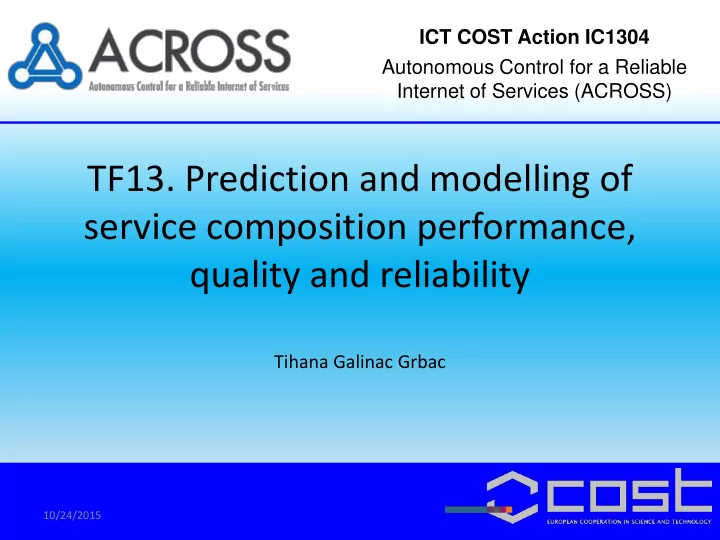

ICT COST Action IC1304 Autonomous Control for a Reliable Internet of Services (ACROSS) TF13. Prediction and modelling of service composition performance, quality and reliability Tihana Galinac Grbac 10/24/2015
TF13 Participants: • Jasmina Barakovic (BH) • Sabina Barakovic (BH) • Nejdet Dogru (BH) • Tihana Galinac Grbac (HR) • Saulius Japertas (LT) • Francesco Lo Presti (IT) • Edmundo Monteiro (PT) • Jamal Raiyn (IS) • Jose Soler (DK) • Hong-Linh Truong (AT) 1 10/24/2015
TF13 Activities: • First meeting: – Discussed topics for State of The Art Document – Already lot of work done and published SOA papers in that domain • STSM – PhD researcher visited Software Engineering and Information Processing Laboratory@RITEH/Croatia – Topic: MRaaS 2 : MapReduce-as-a-Service for QoS-Aware Software-Defined Service Composition • Projects – Workload aware runtime system design in Internet of Services environments, Bilateral project HR-AT – Evolving Software Systems: Analysis and Innovative Approaches for Smart Management (EVOSOFT), Croatian Science Foundation 1 10/24/2015
Work in progress • Impact of service differentiation on quality of next generation services • Uniroma2 activity • A FIRM Approach for Software Defined Service Composition (STSM) 10/24/2015
Impact of service differentiation on quality of next generation services Research Problem and Motivation • Service providers face the challenge of rapidly increasing of signalling, they need to establish methods for handling an explosion of signaling traffic generated by different types of applications. • This may contribute to service quality improvement and service differentiation assurance .
Impact of service differentiation on quality of next generation services Research Activities • Therefore, the module for SIP message differation is developed and integrated into experimental environment. • It is based on Kamailo SIP server as a unified communication platform and Linphone as unified communication client. • Critical service quality performance metrics are measured and analyzed for each component of unified communication service (i.e., audio/video calls, instant messaging, presence) under different load conditions in two scenarios. • Scenarios differ from each other in whether or not the previously developed module for SIP message differentiation is activated. • Collected data are currently statistically analyzed in order to obtain results which will be summarized and presented in form of journal paper.
Uniroma2 activity • Extented and Generalized prior work on SoA optimal service selection algorithm 1. Include Network Latencies • Integer Programming Formulation – Similar to Metric Labeling problem • Working on efficient heuristics 2. Model can also be used to formulate the optimal DSP deployment problem in distributed (Fog Based) clouds – Metrics of interest • Latency, Cost, Reliability, Privacy, Reputation, Trust • Working on Platform to test the solutions – SoA Moses extension – Distributed Implementaiton of Storm for DSP 7
A FIRM Approach for Software Defined Service Composition (STSM) • Service composition - complex web services are designed by composing simpler web services, and offer a complex execution of a business processes • Software defined network uses global network view for network management • Work on : QoS(Quality of Service)-aware Service composition by considering the network congestion, computational load, execution and synchronization delays at service endpoints, and load on the chosen web services or links, in deciding the web services instances for the composition. • Software-Defined Service Composition – based on the centralized global view of the network offered by the Software-Defined Networking (SDN) controller in achieving the QoS-awareness. • Implementation: • web services engines such as Axis2 and CXF for creating web services, • MapReduce frameworks such as Hadoop can provide an effective distributed and scalable alternative for service composition by realizing the web services as MapReduce applications. • OpenDaylight Network Controler 10/24/2015
TF13 Next steps: • Plan next coordination meeting: – Discuss activities and collaborations – Prepare overview of research activities • Work on papers and case studies • Plan STSMs, involve more people, combine research activities, work on more complex scenario 1 10/24/2015
Published papers • V. Cardellini, V. Grassi, F. Lo Presti, M. Nardelli , “Distributed QoS-aware scheduling in Storm”, Proceedings of the 9th ACM International Conference on Distributed Event-Based Systems (DEBS 2015), pp. 344-347, Oslo, Norway, July 2015. doi: 10.1145/2675743.2776766 • V. Cardellini, V. Grassi, F. Lo Presti, M. Nardelli , “On QoS-aware scheduling of data stream applications over Fog computing infrastructures”, Proceedings of the 5th International Workshop on Management of Cloud and Smart City Systems 2015 (MOCS 2015), pp. 944-949, Larnaca, Cyprus, July 2015. • Nikola Tankovic, Tihana Galinac Grbac, Hong-Linh Truong, Schahram Dustdar , Transforming vertical Web applications into Elastic Cloud Applications, Proceedings of International Conference on Cloud Engineering (IC2E 2015), 9- 12 March, 2015, USA. • Tihana Galinac Grbac, C.M. Caba, Jose Soler, Software Defined Networking Demands on Software Technologies, Proc. of MIPRO conference, Opatija, Croatia • Tanković N, Bogunović N, Galinac Grbac T, Žagar M.; Analyzing Incoming Workload in Cloud Business Services, proceedings of Softcom 2015, Bol, Croatia. 10/24/2015
Recommend
More recommend